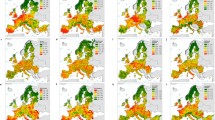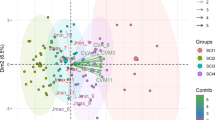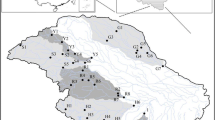Abstract
Japan’s rapid urbanisation over the last 50 years has resulted in land use and lifestyle changes, all of which are likely to have changed the quality of river water, and consequently the wetland and coastal environment. We examined changes in river water quality over this period by means of a review of previous studies. Around the 1950s, the weighted average of chloride using discharge of Japan’s 30 major rivers was 6.1 mg/l while in the 2000s it was 11.3 mg/l. Because there were no significant changes in the natural conditions, we have attributed the increase to the urbanisation of the last 50 years. Nitrate levels in the mountain streams of southern Japan have increased, particularly in the western part of the Kanto region. As this area is located on the leeward side of the Tokyo Metropolitan Area, depositions from aerosols are thought to be the main cause of the increased nitrate concentration. These two findings suggest that certain uses of land may affect river water quality differently over time, and that changes in land use may also affect river water quality in remote areas.




Similar content being viewed by others
References
Aoi T, Mori K, Hirano T (2004) Relationship between the air contaminants flying from the metropolitan area and the nitrogen concentration in mountain stream & rain water around Echigo Mountains. J Environ Eng 41:99–104 (in Japanese)
Baker A (2003) Land use and water quality. Hydrol Process 17:2499–2501. doi:10.1002/hyp.5140
Cohen JE, Small C, Mellinger A, Sachs J (1997) Estimates of coastal populations. Science 278:1209–1213. doi:10.1126/science.278.5341.1209c
Collavini F, Bettiol C, Zaggia L, Zonta R (2005) Pollutant loads from the drainage basin to the Venice Lagoon (Italy). Environ Int 31:939–947. doi:10.1016/j.envint.2005.05.003
Duce RA, LaRoche J, Altieri K, Arrigo KR, Baker AR, Capone DG et al (2008) Impacts of atmospheric anthropogenic nitrogen on the open ocean. Science 320:893–897. doi:10.1126/science.1150369
Hirose T, Kuramoto N (1981) Stream water quality as influenced by land use patterns in the Kakioka basin, Japan. J Environ Qual 10:185–188
Jarvie HP, Oguchi T, Neal C (2002) Exploring the linkages between river water chemistry and watershed characteristics using GIS-based catchment and locality analyses. Reg Environ Change 3:36–50. doi:10.1007/s10113-001-0036-6
Kaneyasu N, Yoshikado H, Mizuno T, Sakamoto K, Soufuku M (1999) Chemical forms and sources of extremely high nitrate and chloride in winter aerosol pollution in the Kanto Plain of Japan. Atmos Environ 33:1745–1756. doi:10.1016/S1352-2310(98)00396-3
Kobayashi J (1955) River water chemistry of Japan, 3rd report—water quality of Kanto region. Nogaku Kenkyo 43:1–40 (in Japanese)
Kobayashi J (1961a) A chemical study on the average quality and characteristics of river waters of Japan. Nogaku Kenkyo 48:63–106 (in Japanese)
Kobayashi J (1961b) Characteristics of the river water of Japan. J Water Waste 2:9–24 (in Japanese)
Konohira E, Shindo J, Yoshioka T, Toda T (2006) Stream water chemistry in Japan. J Jpn Assoc Hydrolog Sci 36:145–149 (in Japanese)
LOICZ (1996) Coastal facts. LOICZ Newslett 1:2
MLIT (Ministry of Land infrastructure Transport and Tourism, Japan) (2002) Water information system. http://www1.river.go.jp. Cited 1 Jul 2008
Neill M (1989) Nitrate concentrations in river waters in the south-east of Ireland and their relationship with agricultural practice. Water Res 23:1339–1355. doi:10.1016/0043-1354(89)90073-0
NIRS (National Institute of Radiological Sciences) (2007) Elemental concentration in the Japanese rivers 2002–2006. NIRS, Chiba, pp 3–93
Okubo T, Fujii S, Imai A (2007) Long-term trends of water quality and new views for conservation of water environment of Lake Biwa. J Water Waste 49:581–592 (in Japanese)
Panigrahi S, Acharya BC, Panigrahy RC, Nayak BK, Banarjee K, Sarkar SK (2007) Anthropogenic impact on water quality of Chilika lagoon RAMSAR site: a statistical approach. Wetlands Ecol Manage 15:113–126. doi:10.1007/s11273-006-9017-3
Sakio H (1999) Comparison of pH values and ionic components of precipitation for 9 years in the Chichibu mountains and Kanto Plain in Saitama Prefecture, Japan. Jpn J For Environ 41:13–17 (in Japanese)
Schoonover JE, Lockaby BG, Pan S (2005) Changes in chemical and physical properties of stream water across an urban-rural gradient in western Georgia. Urban Ecosyst 8:107–124. doi:10.1007/s11252-005-1422-5
Shibata H, Kuraji K, Toda H, Sasa K (2001) Regional comparison of nitrogen export to Japanese forest streams. Sci World J 1:572–580
Smart MM, Jones JR, Sebaugh JL (1985) Stream-watershed relations in the Missouri Ozark Plateau Province. J Environ Qual 14:77–82
Tagami K, Uchida S (2006) Concentrations of chloride, bromine and iodine in Japanese rivers. Chemosphere 65:2358–2365. doi:10.1016/j.chemosphere.2006.04.077
United Nations (2006) World urbanisation prospects—the 2005 revision. UN, New York, pp 1–210
US-EPA (2000) The quality of our nation’s waters. US-EPA, Washington DC, p 19
Wayland KG, Long DT, Hyndman DW, Pijanowski BC, Woodhams SM, Haack SK (2003) Identifying relationships between baseflow geochemistry and land use with synoptic and R-mode factor analysis. J Environ Qual 32:180–190
Woli KP, Nagumo T, Kuramochi K, Hatanod R (2004) Evaluating river water quality through land use analysis and N budget approaches in livestock farming areas. Sci Total Environ 329:61–74. doi:10.1016/j.scitotenv.2004.03.006
Acknowledgements
We wish to thank Dr. Keiko Tagami and her colleagues for their valuable information on monitoring the data of river water chemistry.
Author information
Authors and Affiliations
Corresponding author
Rights and permissions
About this article
Cite this article
Tabayashi, Y., Yamamuro, M. Changes in the impact of anthropogenic effects on river water quality during the last 50 years in Japan. Wetlands Ecol Manage 17, 409–415 (2009). https://doi.org/10.1007/s11273-008-9117-3
Received:
Accepted:
Published:
Issue Date:
DOI: https://doi.org/10.1007/s11273-008-9117-3




